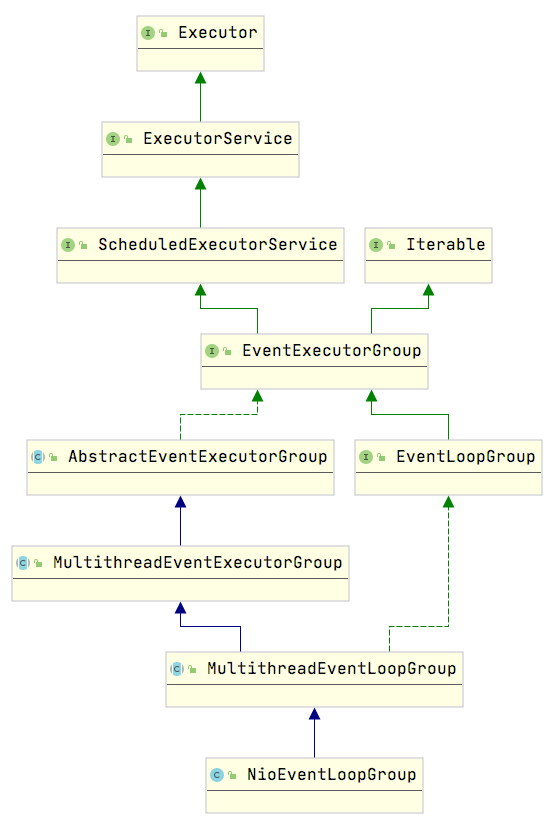4.不完全的 NioEventLoopGroup & NioEventLoop 源码分析
创建服务端时需要先实例化两个 NioEventLoopGroup 分别为 bossGroup 和 workerGroup.
- bossGroup: 只是处理连接请求.
- workerGroup: 处理客户端业务逻辑.

上图是该类的继承关系, 我个人觉得没必要去了解完全这些类的作用, 只需要记住几个重点类就可以了.
EventExecutorGroup
该接口虽然继承了 java.util.concurrent.ScheduledExecutorService, 但是只表示它支持定时任务.
同时标记了 ExecutorService 中的 shutdown() 和 shutdownNow() 方法为过时方法, 并提供了 shutdownGracefully() 方法代替它们.
还有就是最重要的两个方法 next() 和 iterator(), 来管理 EventExecutor:
- next(): 返回这个
EventExecutorGroup管理的一个EventExecutor. - iterator(): 返回这个
EventExecutorGroup管理的所有EventExecutor的集合.
最后 submit 和 schedule 方法的返回值改为了, io.netty.util.concurrent.Future 和 io.netty.util.concurrent.ScheduledFuture.
MultithreadEventExecutorGroup
可以把该类当做是 EventExecutorGroup 的最终实现, 虽然它是一个抽象类. 可以把它看做一个线程池.
主要实现了一下两个方面的功能:
- EventExecutor 管理(创建/结束): EventExecutor 的数据是固定的, 由传入的参数决定.
- 任务派发策略: 创建 EventExecutor 选择器, next 方法使选择器选中一个 Executor.
EventExecutor 选择器是通过 DefaultEventExecutorChooserFactory 对象的 newChooser 方法, 根据 EventExecutor 的数量创建不同的选择器实现 PowerOfTwoEventExecutorChooser 或 GenericEventExecutorChooser.
PowerOfTwoEventExecutorChooser: executors[idx.getAndIncrement() & executors.length - 1];
GenericEventExecutorChooser: executors[Math.abs(idx.getAndIncrement() % executors.length)];
NioEventLoop

SingleThreadEventExecutor
该抽象类中保存了 private volatile Thread thread;, 用来执行一些特定任务. 也就是说一个 NioEventLoop 会和一个线程绑定.
SingleThreadEventLoop
主要实现了 Channel 和 ChannelPromise 的注册.
NioEventLoop
只要实现了获取和调用 Selector.
NioEventLoopGroup 实例化过程
protected MultithreadEventExecutorGroup(int nThreads, Executor executor,
EventExecutorChooserFactory chooserFactory, Object... args) {
if (nThreads <= 0) {
throw new IllegalArgumentException(String.format("nThreads: %d (expected: > 0)", nThreads));
}
// 1. 如果没有指定 executor, 就创建 ThreadPerTaskExecutor.
// ThreadPerTaskExecutor 实例, 主要就是用来创建线程的.
if (executor == null) {
executor = new ThreadPerTaskExecutor(newDefaultThreadFactory());
}
// 2. 根据指定的线程数量, 创建 EventExecutor 数组, 并实例化每个元素.
children = new EventExecutor[nThreads];
for (int i = 0; i < nThreads; i ++) {
boolean success = false;
try {
children[i] = newChild(executor, args);
success = true;
} catch (Exception e) {
throw new IllegalStateException("failed to create a child event loop", e);
} finally {
// 如果构造失败, 就清理资源
}
}
// 3. 创建 EventLoop 选择器.
chooser = chooserFactory.newChooser(children);
// 4. 为每个 EventLoop 线程添加 线程终止监听器
final FutureListener<Object> terminationListener = new FutureListener<Object>() {
@Override
public void operationComplete(Future<Object> future) throws Exception {
if (terminatedChildren.incrementAndGet() == children.length) {
terminationFuture.setSuccess(null);
}
}
};
for (EventExecutor e: children) {
e.terminationFuture().addListener(terminationListener);
}
// 5. 将第二步创建的数组 添加到对应的 set 集合中去重, 表示只可读.
Set<EventExecutor> childrenSet = new LinkedHashSet<EventExecutor>(children.length);
Collections.addAll(childrenSet, children);
readonlyChildren = Collections.unmodifiableSet(childrenSet);
}
可以通过
NioEventLoopGroup的有参构造, 来指定线程数量. 如果没有指定线程数量或指定线程数量为 0 则线程数量会设置为 CPU核心数 * 2.
NioEventLoop 实例化过程
它是在创建完 EventExecutor 数组后, 调用 newChild 方法来进行实例化, newChild 方法在该类中实现.
- 如果没有创建任务队列, 就会先创建任务队列.
- 利用 JDK 提供的 SelectorProvider 直接创建一个 Selector.
- 强制将 Selector 中的 selectedKeys 和 publicSelectedKeys 替换为优化版的 SelectedSelectionKeySet 对象.
- 最后将这个 Selector 包装为 SelectedSelectionKeySetSelector.
SelectedSelectionKeySet 继承 java.util.AbstractSet.
通常来说, NioEventLoop 肩负着两种任务:
- 作为 IO 线程, 执行与 Channel 相关的 IO 操作, 包括 调用 select 等待就绪的 IO 事件、读写数据与数据的处理等;
- 作为任务队列, 执行 taskQueue 中的任务, 例如用户调用 eventLoop.schedule 提交的定时任务也是这个线程执行的.
讨论
1.为什么要替换为 SelectedSelectionKeySet
因为默认的域是 Set 类型, 插入元素的开销是o(log n), 而优化版的 SelectedSelectionKeySet 继承了 AbstractSet, 具有 Set 的功能, 但是内部是用数组实现, 只具有 add 功能, 而且其开销为o(1).
参考资料
EventExecutorGroup
Netty源码分析之服务启动
Netty: DefaultPromise源码解读
认真的 Netty 源码解析(一)
Netty系列(一):NioEventLoopGroup源码解析
netty源码分析--EventLoopGroup与EventLoop 分析netty的线程模型
Netty源码学习(三)NioEventLoop



